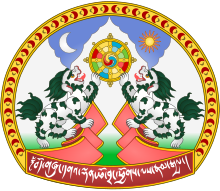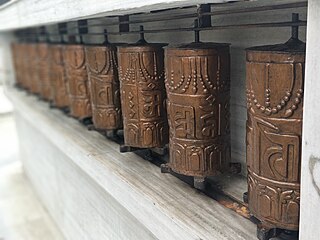
A prayer wheel, or mani wheel, is a cylindrical wheel for Buddhist recitation. The wheel is installed on a spindle made from metal, wood, stone, leather, or coarse cotton. Prayer wheels are common in Tibet and areas where Tibetan culture is predominant.

Padmasambhava, also known as Guru Rinpoche and the Lotus from Oḍḍiyāna, was a tantric Buddhist Vajra master from medieval India who taught Vajrayana in Tibet. According to some early Tibetan sources like the Testament of Ba, he came to Tibet in the 8th century and helped construct Samye Monastery, the first Buddhist monastery in Tibet. However, little more is known about the actual historical figure other than his ties to Vajrayana and Indian Buddhism.

The Kagyu school, also transliterated as Kagyü, or Kagyud, which translates to "Oral Lineage" or "Whispered Transmission" school, is one of the main schools of Tibetan Buddhism. The Kagyu lineages trace themselves back to the 11th century Indian Mahasiddhas Naropa, Maitripa and the yogini Niguma, via their student Marpa Lotsawa (1012–1097), who brought their teachings to Tibet. Marpa's student Milarepa was also an influential poet and teacher.

Buddhist symbolism is the use of symbols to represent certain aspects of the Buddha's Dharma (teaching). Early Buddhist symbols which remain important today include the Dharma wheel, the Indian lotus, the three jewels and the Bodhi tree.
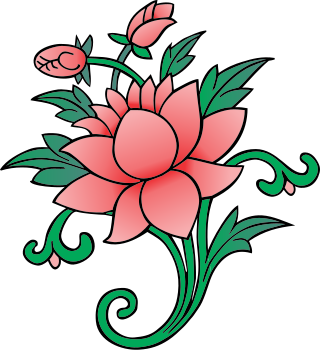
The Drukpa or Drukpa Kagyu lineage, sometimes called Dugpa in older sources, is a branch of the Kagyu school of Tibetan Buddhism. The Kagyu school is one of the Sarma or "New Translation" schools of Tibetan Buddhism. The Drukpa lineage was founded in the Tsang region of Tibet by Tsangpa Gyare (1161–1211), and later became influential in Ladakh and Bhutan. It is one of several lineages known as "Red Hat sects".

In Buddhism, wrathful deities or fierce deities are the fierce, wrathful or forceful forms of enlightened Buddhas, Bodhisattvas or Devas ; normally the same figure has other, peaceful, aspects as well. Because of their power to destroy the obstacles to enlightenment, they are also termed krodha-vighnantaka, "Wrathful onlookers on destroying obstacles". Wrathful deities are a notable feature of the iconography of Mahayana and Vajrayana Buddhism, especially in Tibetan art. These types of deities first appeared in India during the late 6th century, with its main source being the Yaksha imagery, and became a central feature of Indian Tantric Buddhism by the late 10th or early 11th century.
A yidam or iṣṭadevatā is a meditational deity that serves as a focus for meditation and spiritual practice, said to be manifestations of Buddhahood or enlightened mind. Yidams are an integral part of Vajrayana, including both Tibetan Buddhism and Shingon, which emphasize the use of esoteric practices and rituals to attain enlightenment more swiftly. The yidam is one of the three roots of the inner refuge formula and is also the key element of deity yoga. Yidam is sometimes translated by the term "tutelary deity".

The wind horse is a symbol of the human soul in the shamanistic tradition of East Asia and Central Asia. In Tibetan Buddhism, it was included as the pivotal element in the center of the four animals symbolizing the cardinal directions and a symbol of the idea of well-being or good fortune. It has also given the name to a type of prayer flag that has the five animals printed on it.
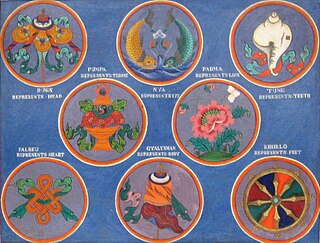
The Ashtamangala is a sacred suite of Eight Auspicious Signs featured in a number of Indian religions such as Hinduism, Jainism, and Buddhism. The symbols or "symbolic attributes" are yidam and teaching tools. Not only do these attributes point to qualities of enlightened mindstream, but they are the investiture that ornaments these enlightened "qualities". Many cultural enumerations and variations of the Ashtamangala are extant.
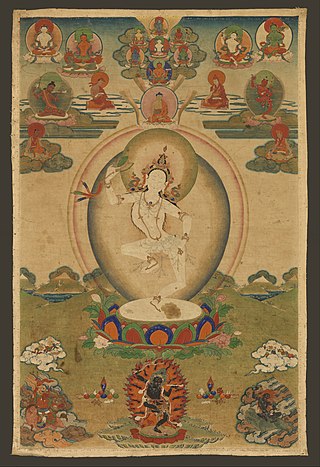
Machig Labdrön, or "Singular Mother Torch from Lab" (1055–1149), was a female Tibetan Buddhist monk believed to be a reincarnation of Yeshe Tsogyal, and the renowned 11th-century Tibetan tantric Buddhist master and yogini that originated several Tibetan lineages of the Vajrayana practice of Chöd.

Vajrayoginī is an important figure in Buddhism, especially revered in Tibetan Buddhism. In Vajrayana she is considered a female Buddha and a ḍākiṇī. Vajrayoginī is often described with the epithet sarvabuddhaḍākiṇī, meaning "the ḍākiṇī [who is the Essence] of all Buddhas". She is an Anuttarayoga Tantra meditational deity (iṣṭadevatā) and her practice includes methods for preventing ordinary death, intermediate state (bardo) and rebirth (samsara) by transforming them into paths to enlightenment, and for transforming all mundane daily experiences into higher spiritual paths.

The Trikāya doctrine is a fundamental doctrine within Mahayana and Vajrayana Buddhism that delineates the multidimensional nature of a Buddha's existence. This concept posits that a Buddha has three distinct bodies or aspects, each representing a different facet of enlightenment. The first body is the Dharmakaya, often referred to as the "Dharma body" or ultimate reality. This embodies the essence of enlightenment itself, encompassing concepts like emptiness, Buddha nature, and pure existence beyond material and spiritual forms.

Tibetan mythology refers to the traditional as well as the religious stories that have been passed down by the Tibetan people. Tibetan mythology consists mainly of national mythology stemming from the Tibetan culture as well as religious mythology from both Tibetan Buddhism and Bön Religion. These myths are often passed down orally, through rituals or through traditional art like sculptures or cave paintings. They also feature a variety of different creatures ranging from gods to spirits to monsters play a significant role in Tibetan mythology with some of these myths have broken into mainstream Western media, with the most notable one being the Abominable Snowman – the Yeti.

Palden Lhamo or Shri Devi is a tantric Buddhist (Vajrayana) goddess who appears in various forms. She usually appears as a wrathful deity with a primary role as a dharmapala. She is specifically a Wisdom Protector, an enlightened being.

The Gankyil or "wheel of joy" is a symbol and ritual tool used in Tibetan and East Asian Buddhism. It is composed of three swirling and interconnected blades. The traditional spinning direction is clockwise, but the counter-clockwise ones are also common.
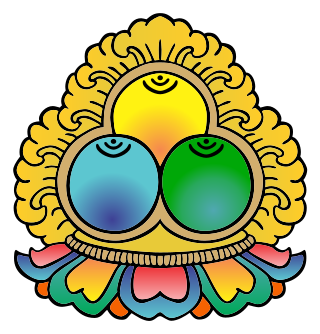
In Tibetan Buddhism, the Three Jewels and Three Roots are supports in which a Buddhist takes refuge by means of a prayer or recitation at the beginning of the day or of a practice session. The Three Jewels are the first and the Three Roots are the second set of three Tibetan Buddhist refuge formulations, the Outer, Inner and Secret forms of the Three Jewels. The 'Outer' form is the 'Triple Gem', the 'Inner' is the Three Roots and the 'Secret' form is the 'Three Bodies' or trikāya of a Buddha.
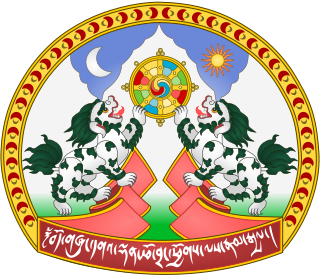
The Emblem of Tibet is a symbol of the Tibetan government in exile. It combines several elements of the flag of Tibet, with slightly different artistry, and contains many Buddhist symbols. Its primary elements are the sun and moon above the Himalayas, which represent Tibet, often known as the Land Surrounded by Snow Mountains. On the slopes of the mountains stand a pair of snow lions. Held between the two lions is the eight-spoked Dharmacakra, represent the Noble Eightfold Path of Buddhism. Inside the wheel, the three-colored swirling jewel represents the practices of the ten exalted virtues and the 16 humane modes of conduct. The inscription on the swirling banner below is as follows: bod gzhung dga' ldan pho brang phyogs las rnam rgyal The Ganden Palace, located in Drepung monastery was the residence of the Dalai Lamas until the 5th Dalai Lama. After the 5th Dalai Lama had moved to the Potala in the mid 17th century the Tibetan Government created by him in 1642 became known as the "Ganden Phodrang" Government.
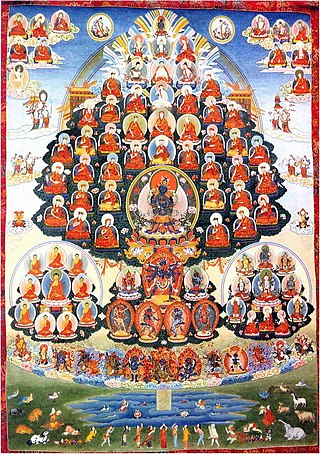
The imagery of the Refuge Tree, also referred to as Refuge Assembly, Refuge Field, Merit Field, Field of Merit or Field of Accumulation is a key part of a visualization and ngöndro practice common to Vajrayana Buddhism. Based on descriptions in the liturgical texts of various traditions, Refuge Trees are often depicted in thangkas employed as objects of veneration, mnemonic devices and as a precursor to the contents being fully visualized by the Buddhist practitioner during the Refuge Formula or evocation.

Dampa Sangye was a Buddhist mahasiddha of the Indian Tantra movement who transmitted many teachings based on both Sutrayana and Tantrayana to Buddhist practitioners in Tibet in the late 11th century. He travelled to Tibet more than five times. On his third trip from India to Tibet he met Machig Labdrön. Dampa Sangye appears in many of the lineages of Chöd and so in Tibet he is known as the Father of Chod, however perhaps his best known teaching is "the Pacification". This teaching became an element of the Mahamudra Chöd lineages founded by Machig Labdrön.

Tsangnyön Heruka, was an author and a master of the Kagyu school of Tibetan Buddhism. Born in Tsang, he is best known as a biographer and compiler of the Life of Milarepa and The Collections of Songs of Milarepa, both classics of Tibetan literature.


